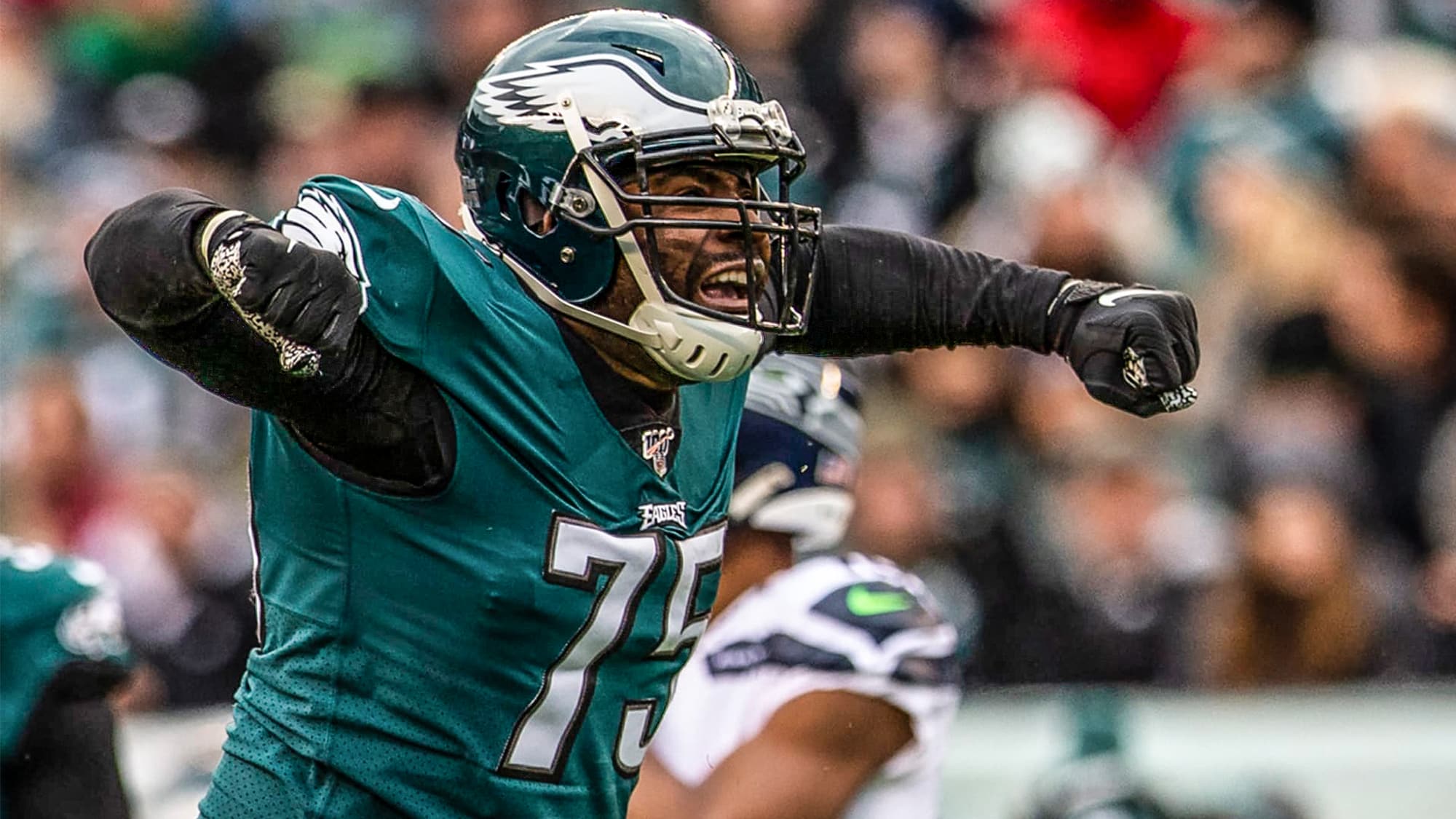Can former Philadelphia Eagles edge rusher Vinny Curry bring some electricity to the New York Jets pass rush even at 33 years old?
Continuing their hot pursuit of pass rushing talent, the New York Jets added one of the league’s most underrated edge rushers in Vinny Curry. A wily veteran from Neptune, NJ, Curry has long been one of the league’s most efficient pass rushers, creating plenty of pressure as a situational player for the Philadelphia Eagles.
In spite of Curry’s on-field play, his age is a definite topic of conversation. The man will turn 33 years old prior to the start of the 2021 season. Does he still have gas left in the tank?
Positives
Pass rushing efficiency
Curry has yet to show any signs of slowing down as a pass rusher. In 2020, he logged 25 pressures on 178 pass-rush snaps, a pressure rate of 14.0% that placed him at the 94th percentile among qualified edge rushers. In 2019, he had 41 pressures on 257 pass-rush snaps for an even more sparkling pressure rate of 16.0% (95th percentile).
Let’s put it into perspective how efficient Curry has been. In 2020, his total of 25 pressures ranked 65th among edge rushers. His total of 178 pass-rush snaps? That ranked 101st.
In 2019, Curry ranked 45th in pressures despite placing 79th in pass-rush snaps.
The veteran makes the absolute most of the opportunities he is given.
Scheme fit
Robert Saleh prefers his edge defenders to be bigger-bodied players who primarily align with their hands in the dirt rather than in a stand-up position. In 2020, San Francisco’s top two edge defenders in terms of snaps, Arik Armstead (292 pounds) and Kerry Hyder (270 pounds) lined up with their hands in the dirt on 94.7% and 95.8% of their defensive snaps, respectively. In 2019, Armstead and Nick Bosa (266 pounds) posted rates of 96.5% and 95.0%.
Curry fits this bill perfectly. A 279-pounder, Curry lined up with his hands in the dirt on 99.1% of his defensive snaps from 2019-20.
Durability
Curry’s overall durability track record is good. Excluding a rookie season in which he was activated to the roster late in the year, Curry played in 117 out of 128 possible regular season games from 2013-20, a 91.4% portion and an average of 14.6 games per year.
However, Curry missed a career-high five games due to injury in 2020. He suffered a hamstring injury in Week 1 that landed him on injured reserve for the next five weeks.
Negatives
Run defense
Curry doesn’t have a great track record against the run. His Pro Football Focus run defense grade of 53.1 in 2020 ranked at the 26th percentile among qualified edge defenders. He has ranked in the top half of the category at his position in only two of the eight seasons in which he qualified (2016 and 2017).
Splashy playmaking
This isn’t necessarily a huge problem, but Curry does not have a knack for making big plays.
Over 123 career games, Curry has only five forced fumbles, two fumble recoveries, and two passes defended. Four of those forced fumbles were in 2014. Both of the pass deflections were in 2013.
Curry does the dirty work, impacting the game in a quiet fashion.
Rough 2018 season in Tampa Bay
Curry has spent only one of his nine NFL seasons outside of the City of Brotherly Love, a one-year stop with the Buccaneers in 2018. That season stands out as the clear worst of his career.
With 24 pressures on 273 pass-rush snaps, Curry posted a pressure rate of 8.8% for Tampa Bay in 2018, which stands as a career-low and ranked at the 34th percentile among qualified edge defenders that season. Over his eight seasons in Philadelphia (save for a rookie season in which he barely played), Curry never ranked in the bottom half of the pressure rate leaderboard, while his worst single-season mark was a solid 10.6% mark in 2014.
Play: 👉 the Jet X Offseason Simulator
Usage/role
Curry has been a rotational player throughout the majority of his career, starting only 28 of 123 career games (22.8%). Of those 28 starts, 16 came in the 2017 season.
In 2020, Curry averaged 28.2 snaps per game, participating in about 42% of the defensive snaps in his average game. He ranged from as low as 26% to as high as 71%.
Curry’s 2019 role was similar. He averaged 24.6 snaps per game and participated in about 40% of the defensive plays on average, ranging from 19% to 75%.
Expect Curry to appear primarily in passing situations. About 69.8% of his career snaps came on a passing play. The 2020 average for edge defenders was a 63.3%/36.7% split between pass and run plays.
However, it’s interesting to note that, as Curry has gotten older, his teams actually began balancing out his deployment rather than making him even more pass-centric. Curry was a true passing-game specialist over his first five seasons, as a whopping 75.6% of his snaps came against the pass over that span. Over the past four seasons, that number was sliced to 64.3%, including a below-average 60.3% in 2020.
Curry plays the majority of his snaps on the edge as a defensive end, which he did on 91.0% of his snaps in 2020. He is also able to kick inside and play some defensive tackle every now and then, playing 9.1% of his snaps at the position over the last three seasons.
The Eagles did not lean towards using Curry on a particular side of the line. He had a 52.4%/47.6% split between the left and right sides of the defensive line over the past two seasons. Generally, Curry tends to line up more often on the strong side of the formation.
Film
There’s nothing quite as joyful as watching a pass rusher subtly make a massive impact on a play without getting any box score credit. Reps like this are Curry’s bread-and-butter.
Here, Curry rushes against Packers right tackle Rick Wagner from a wide alignment. Curry comes in with a bull rush and converts into a long-arm as he removes his outside arm and pushes with solely his inside arm. Curry moves Wagner into Aaron Rodgers’ lap, forcing a dump-off that results in just one yard. Downfield, you can see there are a couple of receivers that Rodgers may have been able to find for a first down if he had one more split-second in the pocket. Curry saves the day.
Curry destroys Bills right tackle Cody Ford with the bull rush on this play, leading to a bad throw by Josh Allen.
The bull rush is clearly Curry’s go-to move, and for good reason, as his bull rush is dominant. He does a good job of getting his pads beneath the pads of the opponent and generates great explosion from his lower body.
Curry also likes to use the rip move. Lined up as the wide-9 technique, Curry throws a rip against the right tackle and bends the corner to apply pressure on Daniel Jones, who attempts a tightly-contested pass that gets broken up.
Here’s a look at Curry showing off his ability to play inside, using his quickness advantage to thrive against interior linemen. He shows a rush into the B-gap before skipping over to the opposite A-gap, swatting the center’s hands and then bringing his arm over to get through. Curry stays balanced as he ricochets off of a teammate, bearing down to lay a hit on Matthew Stafford and force an incomplete pass.
Curry doesn’t have an amazing sideline-to-sideline motor at 30-plus years old and over 270 pounds, but he does do a good job of finding a way to stay involved after his initial rush is thwarted. The following play showcases a second effort by Curry that prevents a massive deep bomb from being completed.
Lined up as the 6-tech (over the tight end), Curry engages the tight end before getting into his rush against the right tackle. Curry tries to win around the corner but is completely shut down. By the time Curry hits the deepest point of his rush, about three full seconds have already passed since the snap – he lost the rep. He doesn’t give up, though. Curry sees Rodgers scramble through the B-gap, so he spins back to the inside in pursuit. Curry dives and hits Rodgers just as he releases the ball, forcing him to miss a wide-open Marquez Valdes-Scantling on what would have been a huge gain.
The Jets are loaded with options who can play the edge, but they still needed some more help there. John Franklin-Myers and Kyle Phillips are tweeners. Franklin-Myers played 5-technique as a rookie for the Rams, but he played substantially better football as an interior defensive lineman in 2020. Phillips has great size and edge-setting skills but hasn’t shown any pass-rushing capabilities on the edge. While both players can be sent out to the edge in certain situations, neither should be out there too often.
Although Bryce Huff and Jabari Zuniga are intriguing EDGE prospects, neither proved enough in their rookie seasons to lock down a guaranteed role in 2020. Huff showed great flashes, but only in spurts. Zuniga seems to be a great scheme fit, but he showed almost nothing in his limited action as a rookie.
So, the Jets needed some more help on the edge opposite Carl Lawson. Getting another full-time starting-caliber player in free agency would probably have been unrealistic, but they needed a pure 4-3 defensive end who they could rely upon to come in and be an effective part of a rotation. There were a lot of veteran options on the market who projected as great fits for this role, and Curry was the most efficient pass rusher among them.
By adding Curry’s tremendous efficiency to a defensive front that also features Lawson (97th percentile in pressure rate among EDGE in 2020), John Franklin-Myers (98th percentile among IDL), Quinnen Williams (89th percentile among IDL), and Sheldon Rankins (71st percentile among IDL), the Jets have built a defensive line that has astronomical potential in the passing game.


